Quasicontinuum Simulation of the Effect of Lotus-Type Nanocavity on the Onset Plasticity of Single Crystal Al during Nanoindentation
Abstract
1. Introduction
2. Quasicontinuum (QC) Model and Initialization
3. Results and Discussion
3.1. The Stress–Displacement Curve and Dislocation Response of Onset Plasticity
3.2. The Effect of the Depth of the Single Circular Cavity on Onset Plasticity
3.3. The Effect of the Diameter of the Single Circular Cavity on Onset Plasticity
3.4. The Effect of the Aspect Ratio of Single Elliptical Cavity on Onset Plasticity
3.5. The Effect of Indenter Size on the Critical Depth
3.6. Surface Orientation Effect
4. Conclusions
Author Contributions
Funding
Acknowledgments
Conflicts of Interest
References
- Weck, A.; Wilkinson, D.S.; Maire, E. Observation of Void Nucleation, Growth and Coalescence in a Model Metal Matrix Composite Using X-ray Tomography. Mater. Sci. Eng. A 2008, 488, 435–445. [Google Scholar] [CrossRef]
- Attar, H.; Löber, L.; Funk, A.; Calin, M.; Zhang, L.C.; Prashanth, K.G.; Scudino, S.; Zhang, Y.S.; Eckert, J. Mechanical Behavior of Porous Commercially Pure Ti and Ti–Tib Composite Materials Manufactured by Selective Laser Melting. Mater. Sci. Eng. A 2015, 625, 350–356. [Google Scholar] [CrossRef]
- Ye, S.; Cao, Q.; Wang, Q.; Wang, T.; Peng, Q. A Highly Efficient, Stable, Durable, and Recyclable Filter Fabricated by Femtosecond Laser Drilling of a Titanium Foil for Oil-Water Separation. Sci. Rep. 2016, 6, 37591. [Google Scholar] [CrossRef] [PubMed]
- Nakajima, H. Fabrication, Properties and Application of Porous Metals with Directional Pores. Prog. Mater. Sci. 2007, 52, 1091–1173. [Google Scholar] [CrossRef]
- Nakajima, H. Mechanical, Thermal and Electrical Properties of Lotus-Type Porous Metals. Mater. Sci. Appl. 2018, 9, 258–267. [Google Scholar] [CrossRef]
- Shepeleva, L.; Medres, B.; Kaplan, W.D.; Bamberger, M.; Weisheit, A. Laser Cladding of Turbine Blades. Surf. Coat. Technol. 2000, 125, 45–48. [Google Scholar] [CrossRef]
- Sexton, L.; Lavin, S.; Byrne, G.; Kennedy, A. Laser Cladding of Aerospace Materials. J. Mater. Process. Technol. 2002, 122, 63–68. [Google Scholar] [CrossRef]
- Suemasu, H.; Takahashi, H.; Ishikawa, T. On Failure Mechanisms of Composite Laminates with an Open Hole Subjected to Compressive Load. Compos. Sci. Technol. 2006, 66, 634–641. [Google Scholar] [CrossRef]
- Wisnom, M.R.; Hallett, S.R. The Role of Delamination in Strength, Failure Mechanism and Hole Size Effect in Open Hole Tensile Tests on Quasi-Isotropic Laminates. Compos. Part A Appl. Sci. Manuf. 2009, 40, 335–342. [Google Scholar] [CrossRef]
- Wang, L.; Xie, L.; Zhang, L.C.; Chen, L.; Ding, Z.; Lv, Y.; Zhang, W.; Lu, W.; Zhang, D. Microstructure evolution and superelasticity of layer-like NiTiNb porous metal prepared by eutectic reaction. Acta Mater. 2018, 143, 214–226. [Google Scholar] [CrossRef]
- Tang, T.; Kim, S.; Horstemeyer, M.F. Molecular Dynamics Simulations of Void Growth and Coalescence in Single Crystal Magnesium. Acta Mater. 2010, 58, 4742–4759. [Google Scholar] [CrossRef]
- Wu, W.P.; Li, Y.L.; Sun, X.Y. Molecular Dynamics Simulation-Based Cohesive Zone Representation of Fatigue Crack Growth in a Single Crystal Nickel. Comput. Mater. Sci. 2015, 109, 66–75. [Google Scholar] [CrossRef]
- Kwon, D.; Asaro, R.J. A Study of Void Nucleation, Growth, and Coalescence in Spheroidized 1518 Steel. Metall. Trans. A 1990, 21, 117–134. [Google Scholar] [CrossRef]
- Saeidi, N.; Ashrafizadeh, F.; Niroumand, B.; Forouzan, M.R.; Barlat, F. Damage Mechanism and Modeling of Void Nucleation Process in a Ferrite–Martensite Dual Phase Steel. Eng. Fract. Mech. 2014, 127, 97–103. [Google Scholar] [CrossRef]
- Bandstra, J.P.; Koss, D.A. On the Influence of Void Clusters on Void Growth and Coalescence during Ductile Fracture. Acta Mater. 2008, 56, 4429–4439. [Google Scholar] [CrossRef]
- Weck, A.; Wilkinson, D.S.; Maire, E.; Toda, H. Visualization by X-ray Tomography of Void Growth and Coalescence Leading to Fracture in Model Materials. Acta Mater. 2008, 56, 2919–2928. [Google Scholar] [CrossRef]
- Tane, M.; Zhao, F.; Song, Y.H.; Nakajima, H. Formation Mechanism of a Plateau Stress Region during Dynamic Compression of Porous Iron: Interaction between Oriented Cylindrical Pores and Deformation Twins. Mater. Sci. Eng. A 2014, 591, 150–158. [Google Scholar] [CrossRef]
- Ehtemam-Haghighi, S.; Cao, G.; Zhang, L.C. Nanoindentation Study of Mechanical Properties of Ti Based Alloys with Fe and Ta Additions. J. Alloys Compd. 2017, 692, 892–897. [Google Scholar] [CrossRef]
- Wang, L.; Xie, L.; Lv, Y.; Zhang, L.C.; Chen, L.; Meng, Q.; Qu, J.; Zhang, D.; Lu, W. Microstructure Evolution and Superelastic Behavior in Ti-35Nb-2Ta-3Zr Alloy Processed by Friction Stir Processing. Acta Mater. 2017, 131, 499–510. [Google Scholar] [CrossRef]
- Voisin, T.; Krywopusk, N.M.; Mompiou, F.; Weihs, T.P. Precipitation Strengthening in Nanostructured AZ31B Magnesium Thin Films Characterized by Nano-indentation, STEM/EDS, HRTEM, and in situ TEM Tensile Testing. Acta Mater. 2017, 138, 174–184. [Google Scholar] [CrossRef]
- Horstemeyer, M.F.; Baskes, M.I.; Plimpton, S.J. Length Scale and Time Scale Effects on the Plastic Flow of Fcc Metals. Acta Mater. 2007, 49, 4363–4374. [Google Scholar] [CrossRef]
- Gouldstone, A.; Chollacoop, N.; Dao, M.; Li, J.; Minor, A.M.; Shen, Y.L. Indentation Across Size Scales and Disciplines: Recent Developments in Experimentation and Modeling. Acta Mater. 2007, 55, 4015–4039. [Google Scholar] [CrossRef]
- Li, J.; Vilet, K.J.V.; Zhu, T.; Yip, S.; Suresh, S. Atomistic Mechanisms Governing Elastic Limit and Incipient Plasticity in Crystals. Nature 2002, 418, 307. [Google Scholar] [CrossRef] [PubMed]
- Craighead, H.G. Nanoelectromechanical Systems. Science 2000, 290, 1532–1535. [Google Scholar] [CrossRef] [PubMed]
- Minor, A.M.; Asif, S.A.; Shan, Z.; Stach, E.A.; Cyrankowski, E.; Wyrobek, T.J.; Warren, O.L. A New View of the Onset of Plasticity during the Nanoindentation of Aluminum. Nat. Mater. 2006, 5, 697–702. [Google Scholar] [CrossRef] [PubMed]
- Tsuru, T.; Shibutani, Y. Atomistic Simulations of Elastic Deformation and Dislocation Nucleation in Al under Indentation-Induced Stress Distribution. Model. Simul. Mater. Sci. Eng. 2006, 14, S55–S62. [Google Scholar] [CrossRef]
- Li, Z.R.; Lim, C.W.; He, L.H. Stress Concentration around a Nano-Scale Spherical Cavity in Elastic Media: Effect of Surface Stress. Eur. J. Mech. A Solids 2006, 25, 260–270. [Google Scholar] [CrossRef]
- Ou, Z.Y.; Wang, G.F.; Wang, T.J. Effect of Residual Surface Tension on the Stress Concentration around a Nanosized Spheroidal Cavity. Int. J. Eng. Sci. 2008, 46, 475–485. [Google Scholar] [CrossRef]
- Lu, N.; Du, K.; Lu, L.; Ye, H.Q. Transition of Dislocation Nucleation Induced by Local Stress Concentration in Nanotwinned Copper. Nat. Commun. 2015, 6, 7648. [Google Scholar] [CrossRef] [PubMed]
- Wu, H.A.; Liu, G.R.; Wang, J.S. Atomistic and Continuum Simulation on Extension Behaviour of Single Crystal with Nano-Holes. Model. Simul. Mater. Sci. Eng. 2004, 12, 225–233. [Google Scholar] [CrossRef]
- Yang, X.; Zhou, T.; Chen, C. Effective Elastic Modulus and Atomic Stress Concentration of Single Crystal Nano-Plate with Void. Comput. Mater. Sci. 2007, 40, 51–56. [Google Scholar] [CrossRef]
- Miller, R.E.; Tadmor, E.B. The Quasicontinuum Method: Overview, Applications and Current Directions. J. Comput. Aided Mater. Des. 2002, 9, 203–239. [Google Scholar] [CrossRef]
- Peng, Q.; Zhang, X.; Hung, L.; Carter, E.A.; Lu, G. Quantum Simulation of Materials at Micron Scales and Beyond. Phys. Rev. B 2008, 78, 054118. [Google Scholar] [CrossRef]
- Peng, Q.; Zhang, X.; Lu, G. Quantum mechanical simulations of nanoindentation of Al thin film. Comput. Mater. Sci. 2010, 47, 769–774. [Google Scholar] [CrossRef]
- Jin, J.; Shevlin, S.; Guo, Z. Multiscale Simulation of Onset Plasticity during Nanoindentation of Al (001) Surface. Acta Mater. 2008, 56, 4358–4368. [Google Scholar] [CrossRef]
- Yu, W.; Shen, S. Multiscale Analysis of the Effects of Nanocavity on Nanoindentation. Comput. Mater. Sci. 2009, 46, 425–430. [Google Scholar] [CrossRef]
- Péron-Lührs, V.; Sansoz, F.; Noels, L. Quasicontinuum Study of the Shear Behavior of Defective Tilt Grain Boundaries in Cu. Acta Mater. 2014, 64, 419–428. [Google Scholar] [CrossRef]
- Ponga, M.; Ortiz, M.; Ariza, M.P. A Comparative Study of Nanovoid Growth in Fcc Metals. Philos. Mag. 2017, 97, 2985–3007. [Google Scholar] [CrossRef]
- Foiles, S.M.; Baskes, M.I.; Daw, M.S. Embedded-Atom-Method Functions for the Fcc Metals Cu, Ag, Au, Ni, Pd, Pt, and Their Alloys. Phys. Rev. B 1986, 33, 7983. [Google Scholar] [CrossRef]
- Knap, J.; Ortiz, M. Effect of Indenter-Radius Size on Au (001) Nanoindentation. Phys. Rev. Lett. 2003, 90, 226102. [Google Scholar] [CrossRef] [PubMed]
- Hayes, R.; Fago, M.; Ortiz, M.; Carter, E. Prediction of Dislocation Nucleation during Nanoindentation by the Orbital-Free Density Functional Theory Local Quasi-Continuum Method. Multiscale Model. Simul. 2005, 4, 359–389. [Google Scholar] [CrossRef]
- Hirth, J.; Lothe, J. Theory of Dislocations, 2nd ed.; John Wiley & Sons Inc.: Cleveland, NJ, USA, 1982; p. 322. [Google Scholar]
- Zhou, L.; Huang, H. Are Surfaces Elastically Softer or Stiffer? Appl. Phys. Lett. 2004, 84, 1940–1942. [Google Scholar] [CrossRef]
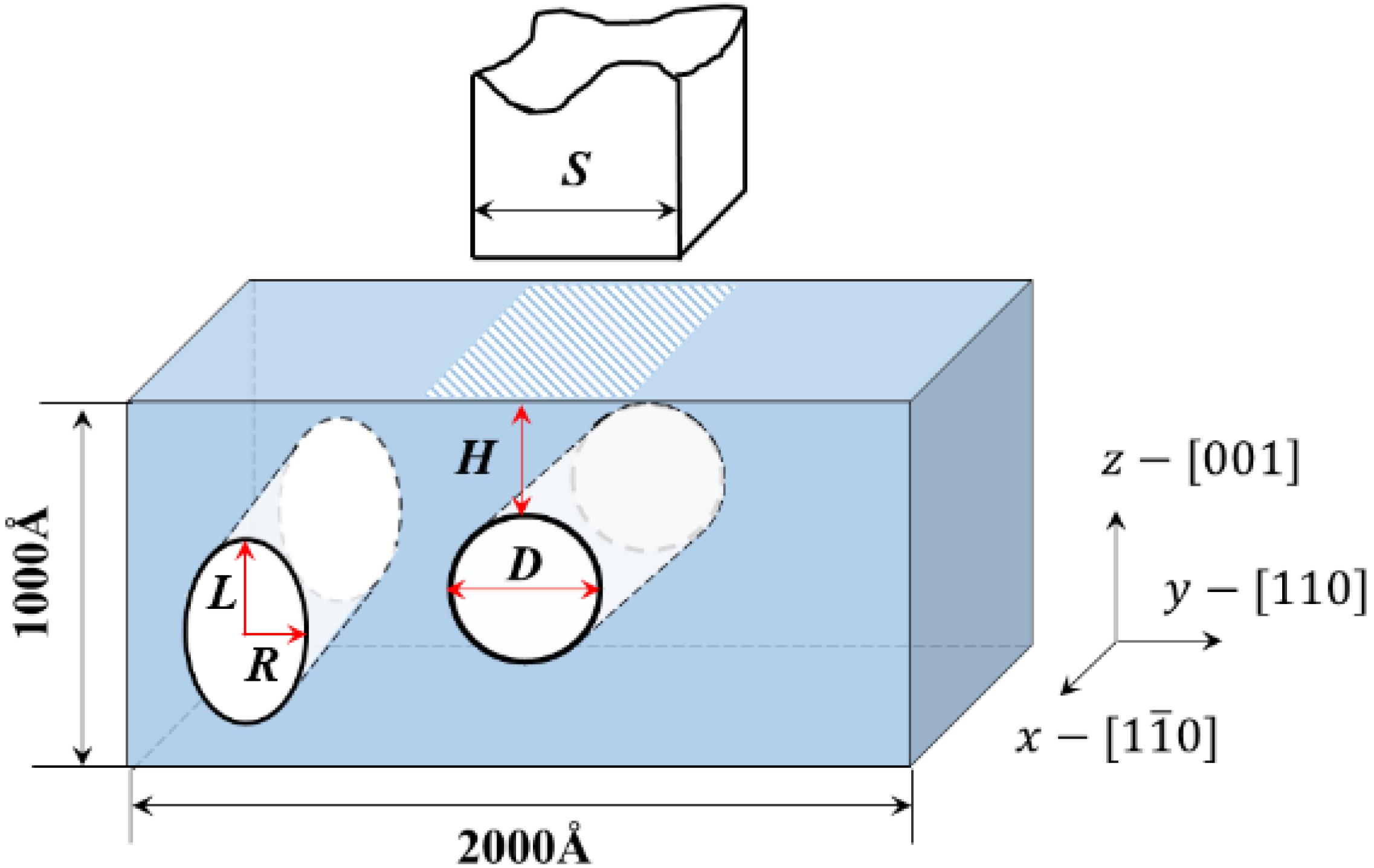
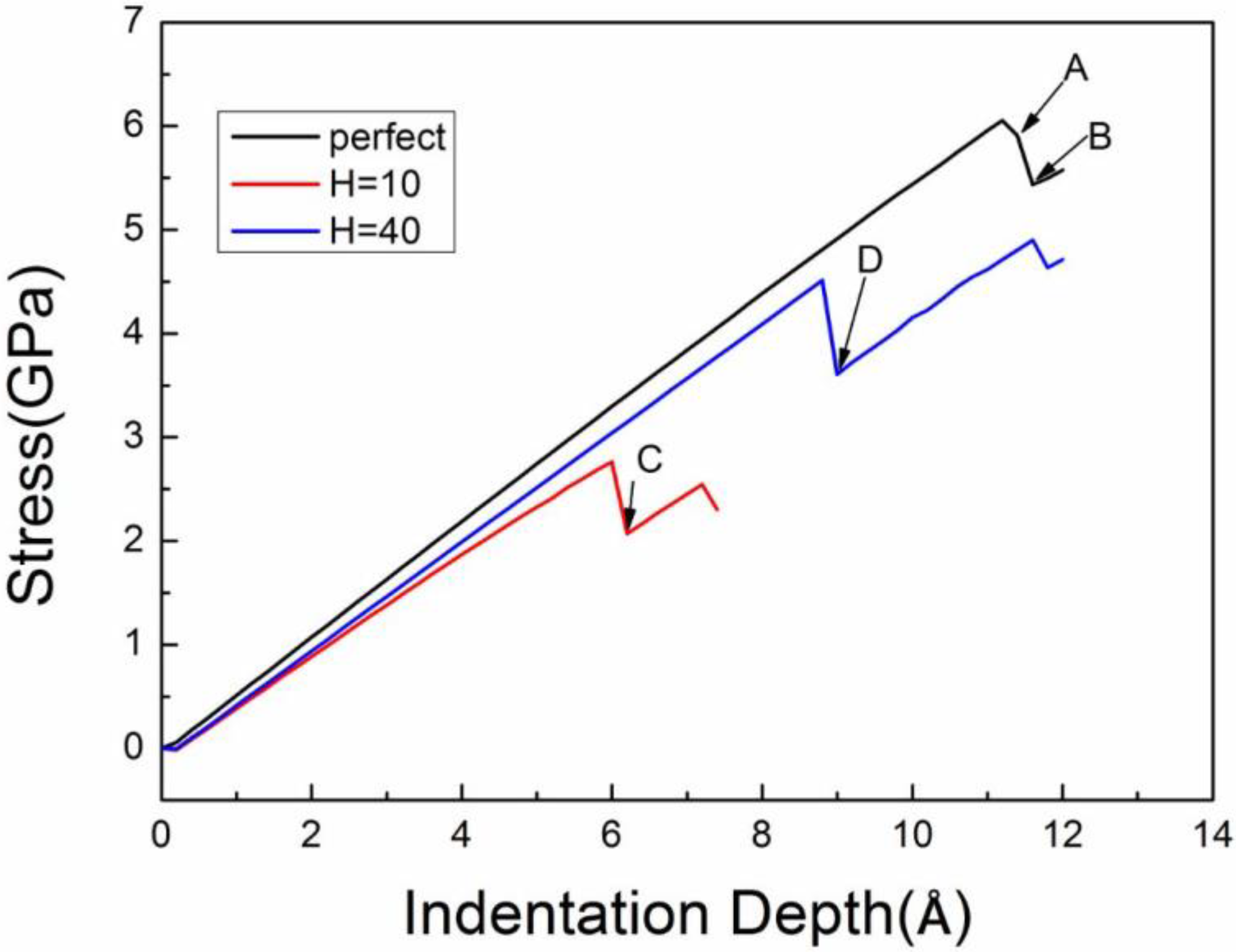

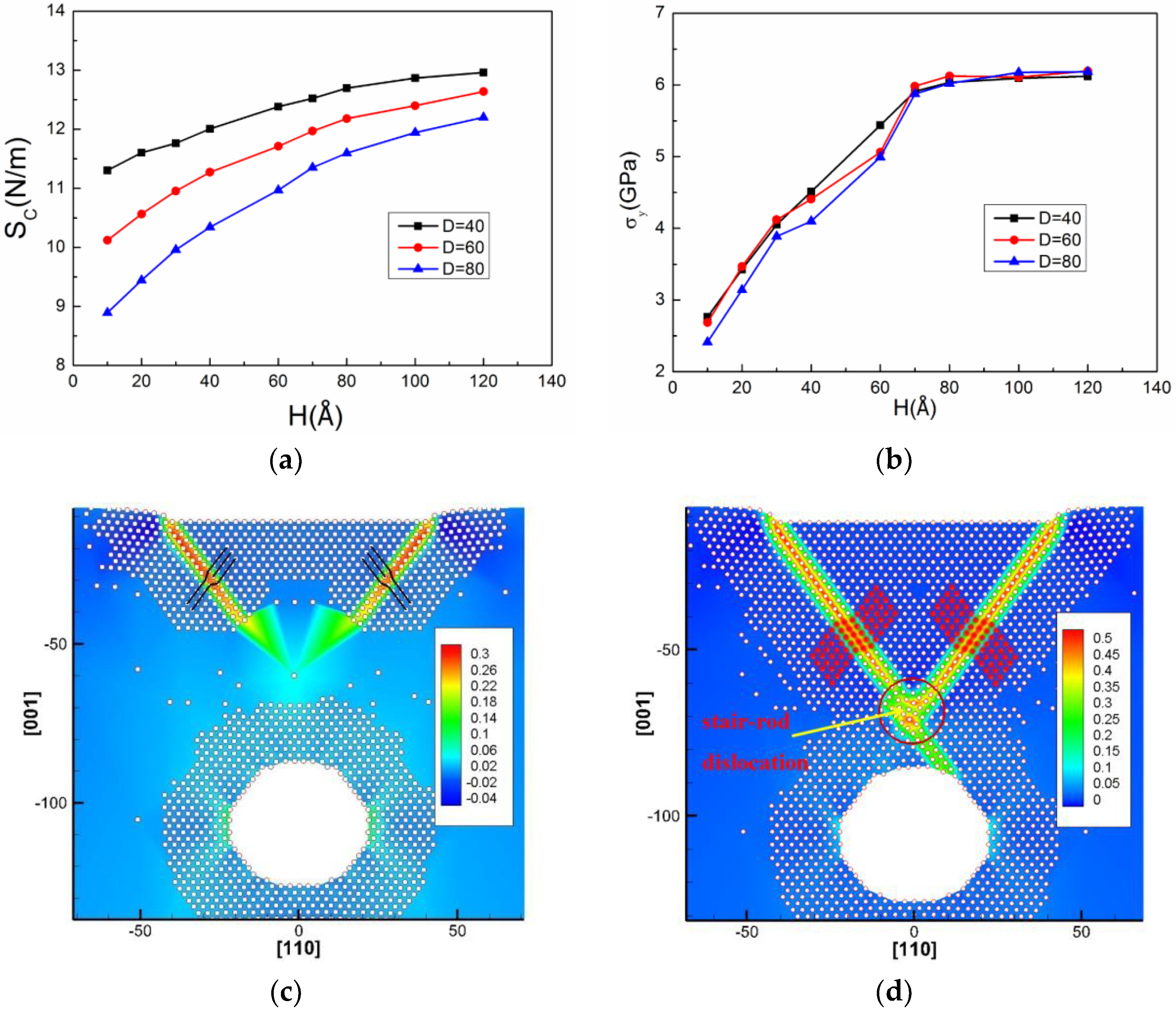

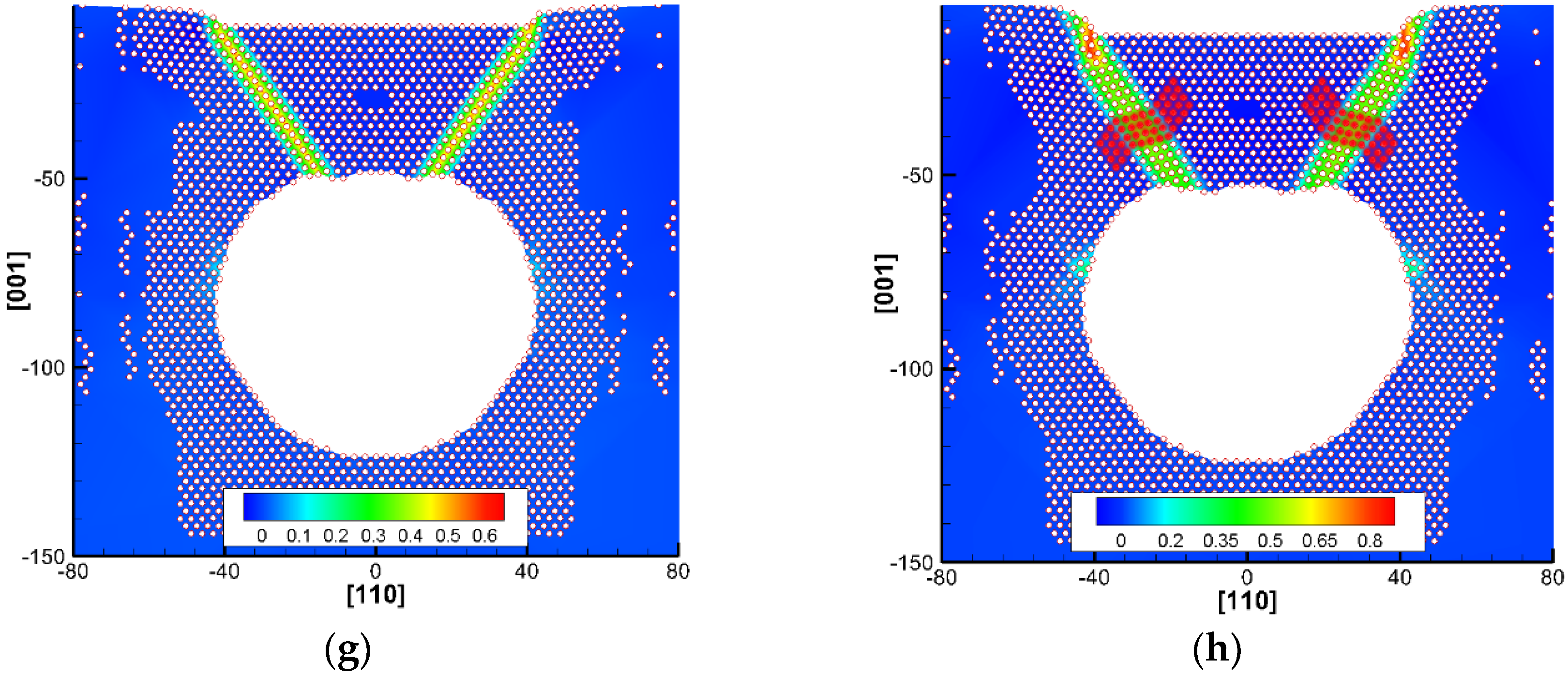
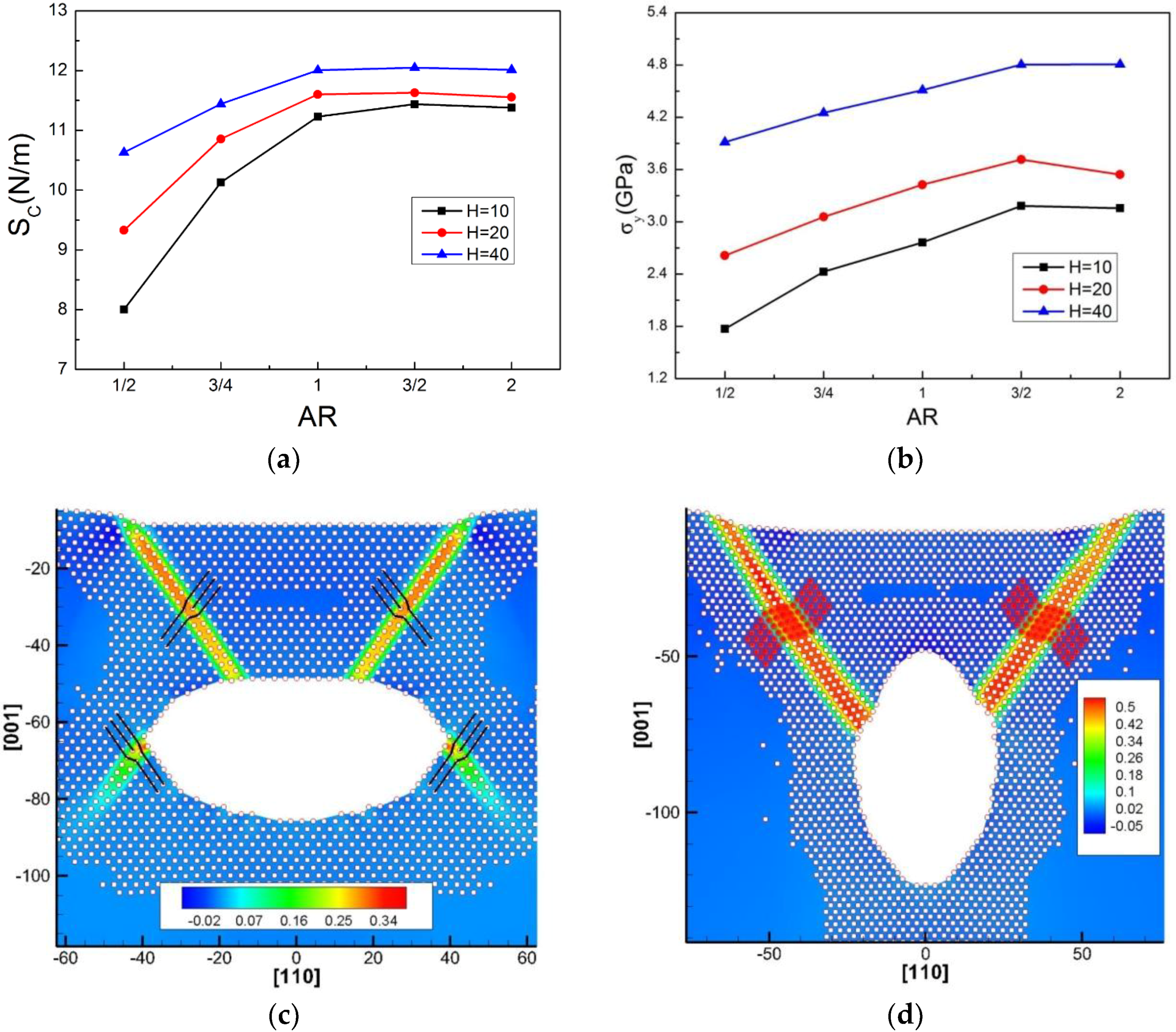
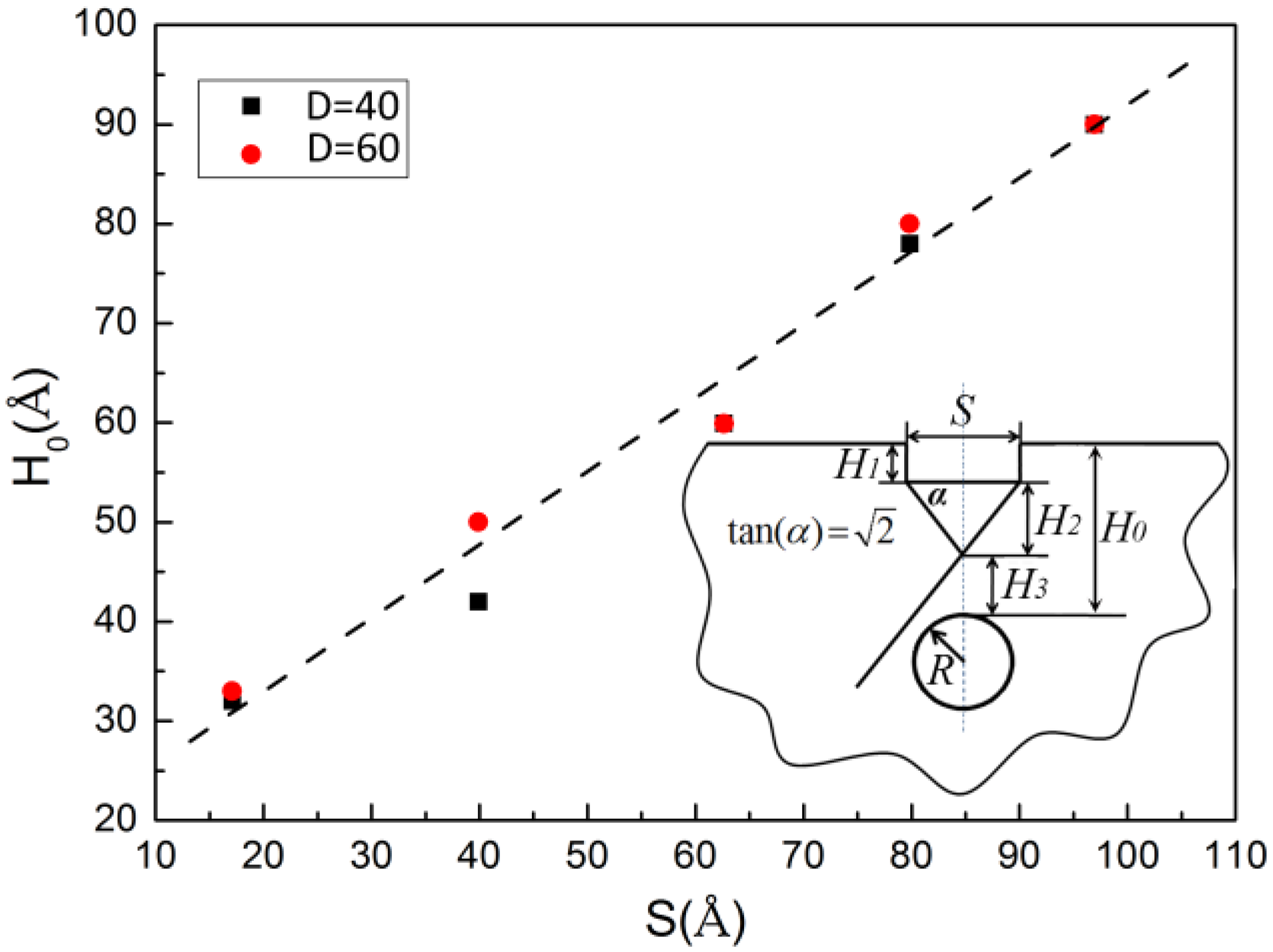
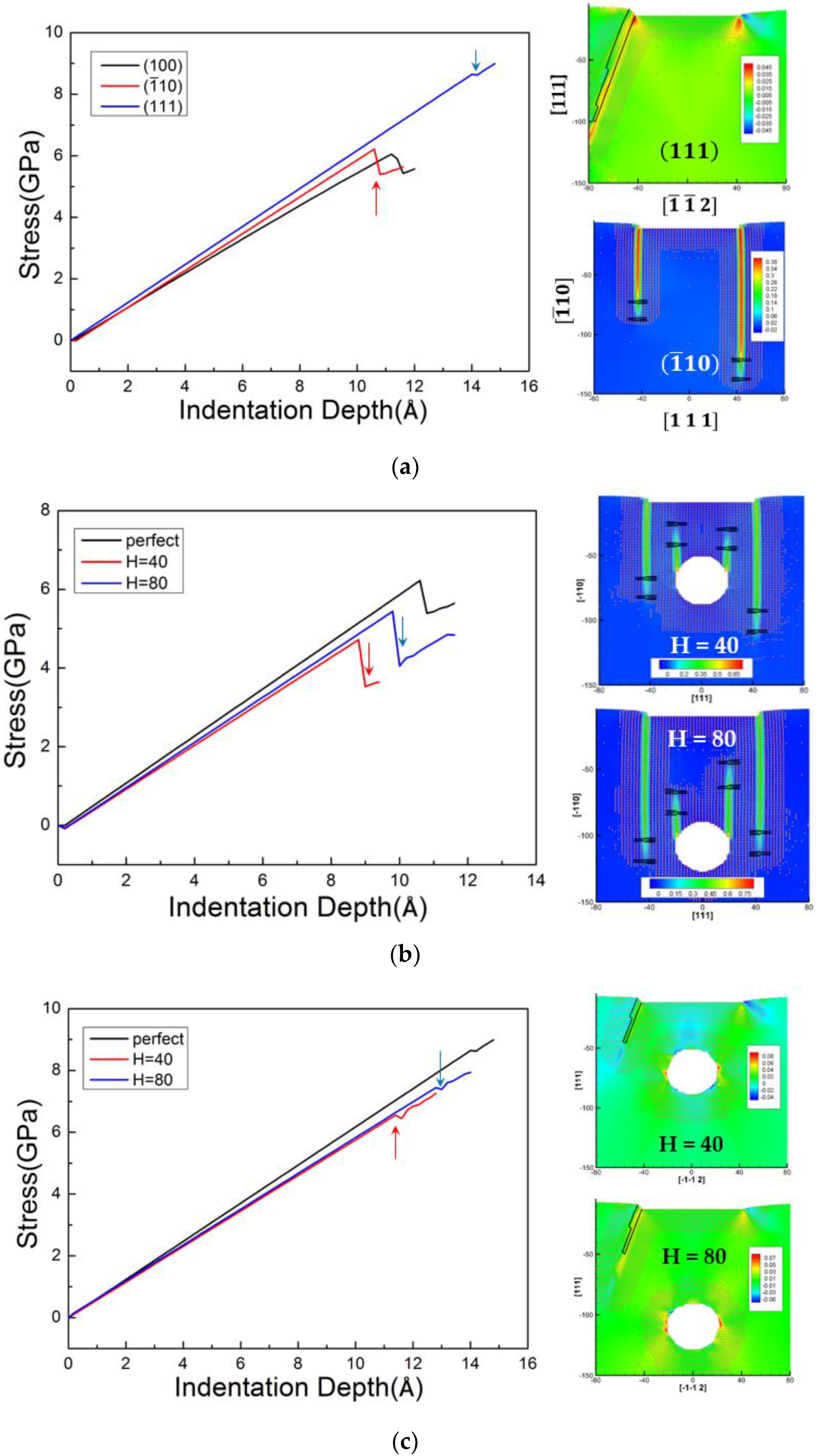
© 2018 by the authors. Licensee MDPI, Basel, Switzerland. This article is an open access article distributed under the terms and conditions of the Creative Commons Attribution (CC BY) license (http://creativecommons.org/licenses/by/4.0/).
Share and Cite
Jin, J.; Yang, P.; Cao, J.; Li, S.; Peng, Q. Quasicontinuum Simulation of the Effect of Lotus-Type Nanocavity on the Onset Plasticity of Single Crystal Al during Nanoindentation. Nanomaterials 2018, 8, 778. https://doi.org/10.3390/nano8100778
Jin J, Yang P, Cao J, Li S, Peng Q. Quasicontinuum Simulation of the Effect of Lotus-Type Nanocavity on the Onset Plasticity of Single Crystal Al during Nanoindentation. Nanomaterials. 2018; 8(10):778. https://doi.org/10.3390/nano8100778
Chicago/Turabian StyleJin, Jianfeng, Peijun Yang, Jingyi Cao, Shaojie Li, and Qing Peng. 2018. "Quasicontinuum Simulation of the Effect of Lotus-Type Nanocavity on the Onset Plasticity of Single Crystal Al during Nanoindentation" Nanomaterials 8, no. 10: 778. https://doi.org/10.3390/nano8100778
APA StyleJin, J., Yang, P., Cao, J., Li, S., & Peng, Q. (2018). Quasicontinuum Simulation of the Effect of Lotus-Type Nanocavity on the Onset Plasticity of Single Crystal Al during Nanoindentation. Nanomaterials, 8(10), 778. https://doi.org/10.3390/nano8100778





